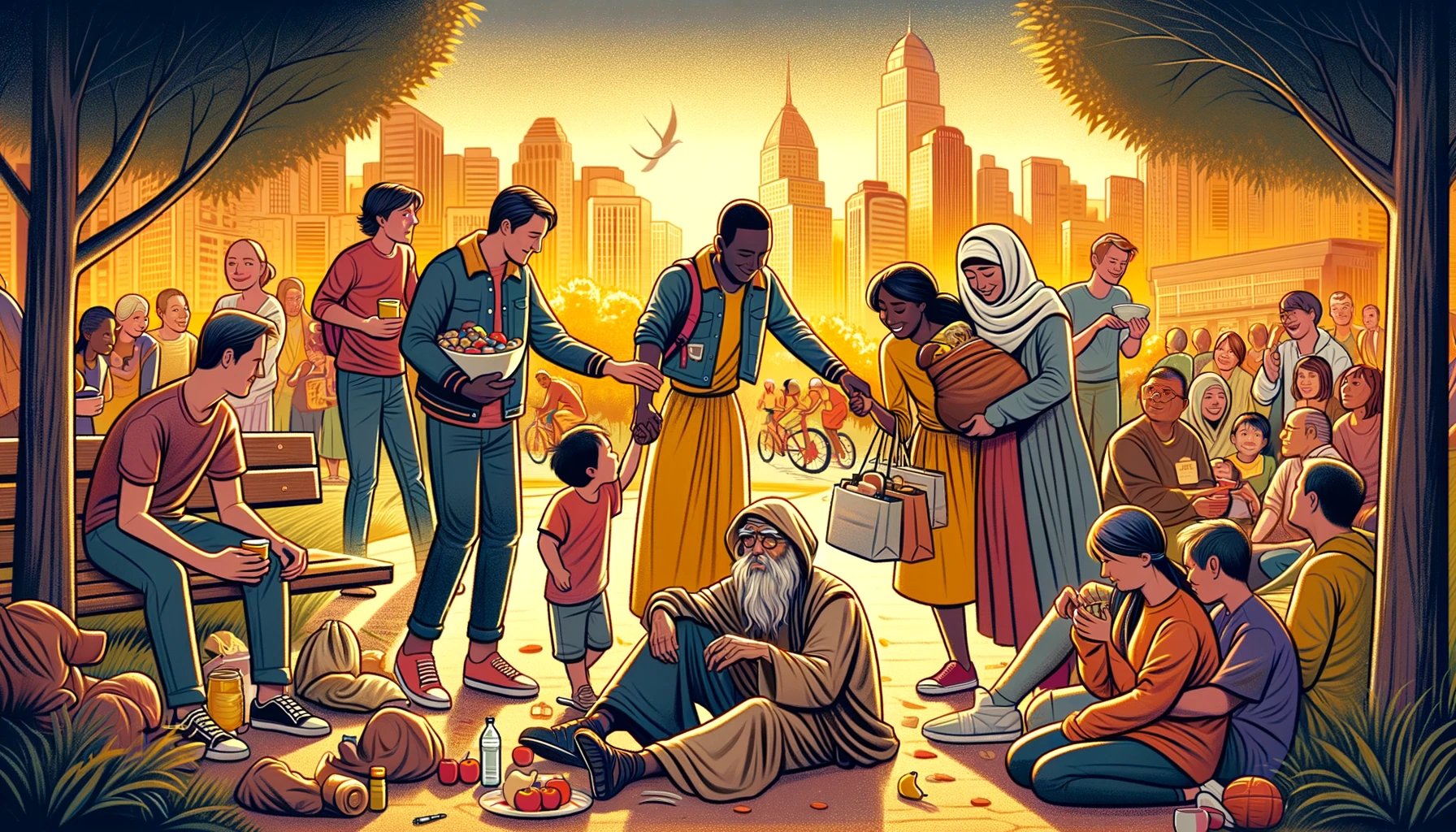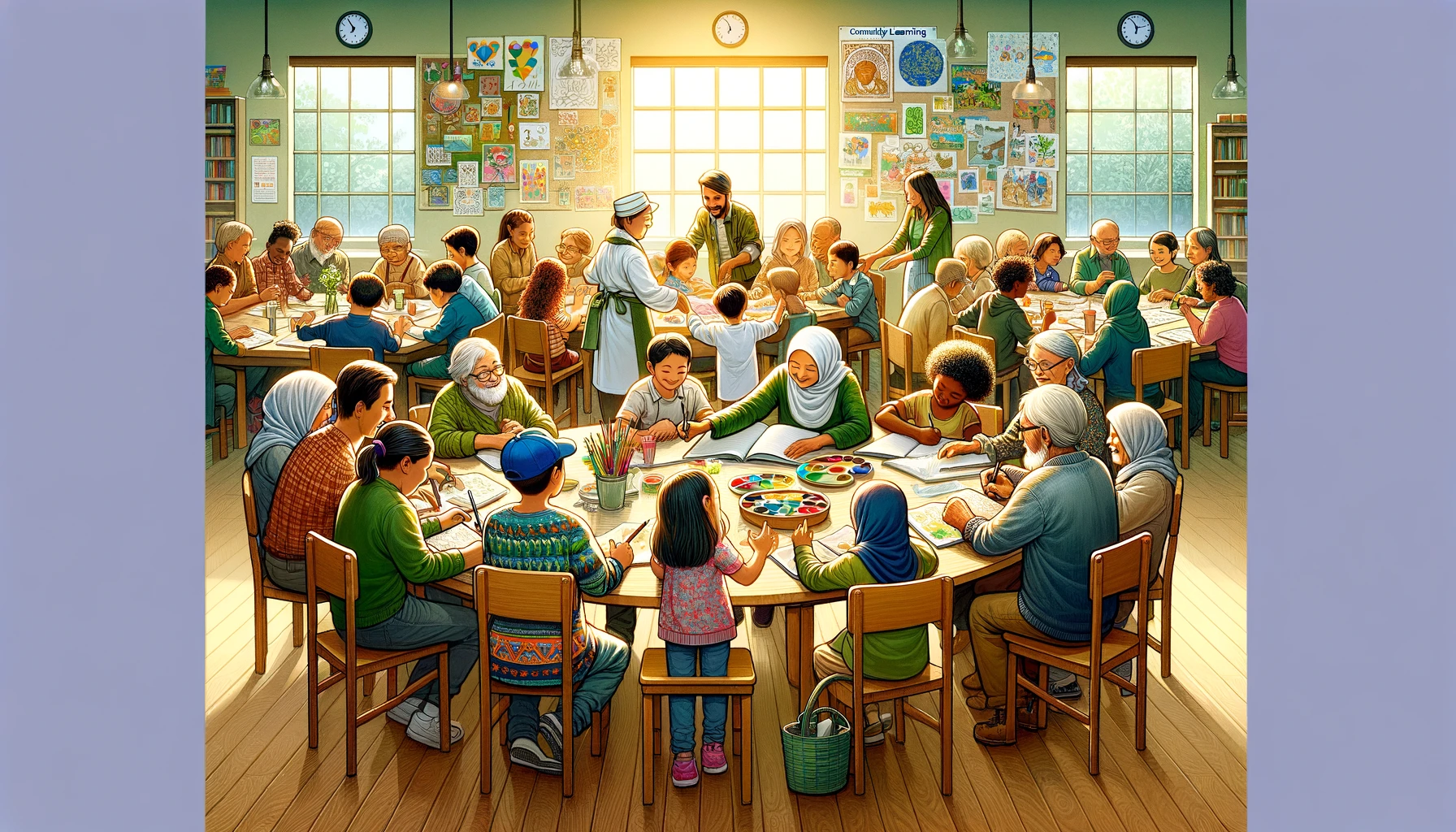In an era marked by divisions and indifference, the story of the Good Samaritan stands out as a beacon of humanity. This parable, woven into the fabrics of the Holy Scriptures, continues to be a source of inspiration and an invitation to reflect on the true meaning of love and altruism.
By exploring the essence of this biblical narrative, we are led on a journey that challenges our preconceived notions and encourages us to transcend the boundaries imposed by social and cultural barriers.
The Parable of the Good Samaritan, told by Jesus in response to the question “Who is my neighbor?”, reveals a profound understanding of compassion and moral duty.
The account of a man who, unlike the other passersby, does not hesitate to help a stranger injured on the side of the road, questions the listeners and readers: are we truly willing to lend a hand, regardless of the differences that may exist between us?
With this article, we invite you to delve into the depths of this ancient story, which still resonates in our modern lives. How can the attitude of the Good Samaritan be applied in our daily lives?
In what ways can we incorporate the lessons of empathy and unconditional service into our interethnic relationships and within an increasingly globalized society?
As you journey through the lines of this text, prepare to uncover the layers of meaning hidden behind the actions of the Good Samaritan. We are faced with a unique opportunity to understand how this biblical teaching can be translated into concrete acts of kindness, transforming not only the lives of those who receive help but also of those who are willing to provide it.
Join us in this detailed analysis and allow the message of the Good Samaritan to inspire your personal journey towards a more compassionate world. Will you, by the end of this reading, feel compelled to be a Good Samaritan in today’s world? The answer may surprise both us and those around us.

The Essence of Empathy in Action
The parable of the Good Samaritan transcends mere acts of assistance; it delves into the complex layers of empathy and understanding of others in their most urgent needs. In a society where frenetic rhythms often surpass the capacity for pause and reflection, the story calls us to reassess our priorities and the quality of our attention to others.
The Samaritan’s Reflection in the Modern World
The attitude of the Good Samaritan is mirrored in numerous contemporary actions ranging from small everyday gestures to large humanitarian initiatives. Various social movements and non-governmental organizations are practical examples of how this altruism can be materialized.
Médecins Sans Frontières (Doctors Without Borders), for example, is an international organization that reflects the Samaritan spirit by providing medical assistance in conflict regions, regardless of the nationality or creed of the people assisted.
Practicing Altruism in Our Daily Lives
In daily life, being a Good Samaritan can manifest through simple actions such as:
- Offering help to someone who is clearly lost or in distress on the street.
- Participating in volunteer programs in local communities.
- Expressing kindness and words of support to those going through a difficult time.
Each of these acts, though small, carries the essence of the biblical parable, which is the ability to put oneself in the shoes of others and act with kindness and compassion.

Contemporary Challenges to Samaritan Practice
However, living as a Good Samaritan in current times presents its challenges. In a world where prejudices and divisions still prevail, practicing unconditional compassion requires not only empathy but also courage and determination. Overcoming the barriers of fear and mistrust is a necessary step towards approaching the Samaritan ideal of helping others.
In conclusion, the parable of the Good Samaritan goes beyond a story; it is a call to action. It encourages us to look beyond our differences and to find common humanity in all of us. By applying these lessons in our lives, we not only help build a better world but also grow in our own character and understanding of what it truly means to be human.
The Relevance of the Good Samaritan in Interethnic Relations
The Parable of the Good Samaritan is particularly significant when considering the interethnic tensions that still permeate contemporary society. The biblical narrative, with its focus on compassionate action between individuals of different backgrounds, serves as a powerful reminder of the importance of respect and solidarity among diverse ethnicities.
Overcoming Prejudices Through Compassion
In the story, the Good Samaritan comes from a group that was viewed with disdain by the original listeners of the parable. Yet, he is the only one who shows compassion for the injured man on the road, a Jew, who would otherwise be considered his enemy. This act challenges prejudices and shows that kindness and love for others transcend ethnic and cultural barriers.

A Look at the Statistics
Recent research highlights the need for more interethnic understanding. A study by the Pew Research Center, for example, revealed that in 2019, 76% of adults said that racial and ethnic tensions are a major problem in society. This high index suggests an urgency in adopting the lessons of the Good Samaritan in our social behavior (Pew Research Center).
Practical Examples of Interethnic Altruism
There are many contemporary examples of Samaritan actions that have overcome ethnic divisions, such as reconciliation initiatives in post-conflict countries, which seek to heal the wounds left by years of interethnic violence. Organizations like ‘Conciliation Resources’ work to empower communities to deal with their differences constructively, promoting peaceful coexistence (Conciliation Resources).
Education for Empathy
Education plays a fundamental role in promoting deeper interethnic understanding, inspired by the Good Samaritan. School programs that implement diversity and inclusion-focused curricula are crucial in shaping young people capable of acting with empathy and respect for cultural differences.
Conclusion: Living as a Good Samaritan Today
The Parable of the Good Samaritan invites us to reflect on how we can live out these values in our own lives. It encourages us to question our prejudices and to act with kindness, even when it is easier to look away. By embracing the lessons of love and altruism from the Good Samaritan, we can contribute to a more just and empathetic society, where differences are celebrated and mutual aid is the norm.
The challenge is set: can we be the next Good Samaritan someone encounters on their journey? The answer to this question may not only change someone else’s life but also our own.
Reflecting on the Path of Altruism
Throughout this article, we navigated the waters of the Parable of the Good Samaritan, revisiting its timeless lessons of love and altruism. We have seen how this narrative, though ancient, resonates powerfully in our days, offering a moral compass to guide our behavior in a society fragmented by divisions and prejudices.
The essence of empathy that emerges from the story is not only a virtue to be admired but a call to action that drives us to transcend barriers and connect with others on a genuinely human level.
The Timeliness of an Ancient Message
The parable echoes in our actions when we choose to be the outstretched hand rather than the averted gaze. In a world where news often brings reports of intolerance and inhumanity, the practice of altruism becomes a revolutionary act of resistance and hope.
The story of the Good Samaritan reminds us that, regardless of ethnic, cultural, or religious differences, we are called to act with compassion and to offer selfless help to those in need.
Building Bridges of Solidarity
Recognizing the importance of interethnic relations in building an inclusive and just society, the parable challenges us to break down the walls of prejudice and to build bridges of understanding and solidarity.
In doing so, we not only help heal existing divisions but also pave the way for a future where diversity is seen as a wealth to be celebrated, not as a divisive factor.
As we move towards the final conclusion of this article, we carry with us the powerful message of the Good Samaritan: a message that is not limited to words but manifests in concrete acts of kindness and humanity.
May the reflections presented here inspire each reader to become, in their own context, a living reflection of this parable, experiencing and spreading love for others as a path to a more empathetic and united world.
May the words and reflections shared here resonate in our hearts and minds, and may the journey of altruism be one that we choose to walk together, today and always.
With the stories and reflections on the Good Samaritan still fresh in our minds, we invite you to carry this dialogue forward. Share your perspective in the comments below – how have you experienced the lessons of this parable in your life? Is there any personal experience that reflects the essence of altruism and compassion that you would like to share?
Furthermore, if this article has sparked in you the desire to deepen your biblical knowledge, we encourage you to explore further. Study the Parable of the Good Samaritan in its original context and discover other passages that speak about love for others and altruistic service.
And if you feel inspired, do not keep this inspiration just for yourself. Share this article with friends, family, or on your social networks and spread the powerful messages of love and compassion that can transform our world.
Engage, reflect, and act. Be a Good Samaritan in your community and beyond. Let us together build a legacy of kindness and empathy that will echo through generations.
Your journey of altruism begins now. How will you answer it?
Comment, share, and continue the journey. 🕊️✨
Questions and Answers about the Parable of the Good Samaritan
What is the historical importance of Samaritans in the parable?
Samaritans were members of an ethnic-religious group that shared many beliefs and practices with the Jews, but there were significant differences that caused animosity between the two groups. In Jesus’ time, Samaritans and Jews generally avoided contact with each other.
Therefore, the use of a Samaritan as the hero of the parable was quite impactful and subversive, challenging the social and religious norms of the time.
How can I apply the lessons of the Good Samaritan in my everyday life?
To apply the lessons of the Good Samaritan in daily life, look for opportunities to help others without expecting anything in return. This can be as simple as listening to someone who is having a bad day or helping a neighbor with groceries.
The central point is the practice of compassion and kindness, especially towards those who may not be able to reciprocate or who are often marginalized.
Is there any controversy about the interpretation of this parable?
Yes, as with many biblical texts, the interpretation of the Parable of the Good Samaritan can vary. Some scholars see the parable as a lesson about social justice and the need to help the marginalized, while others interpret it more directly as a call to love everyone as neighbors.
Additionally, debates about the role of works versus faith for salvation also intertwine with the interpretation of this story.
How does the Parable of the Good Samaritan relate to modern teachings on ethics?
The parable is often cited in modern discussions about ethics and morality, especially in the context of selfless altruism and social action. It underscores the importance of active compassion and assistance to strangers, regardless of their identity.
The parable is often used as an example of how actions are more important than beliefs or words when it comes to ethics and justice.
Can the Good Samaritan be considered a model for interreligious relations?
Definitely. The parable can be seen as a call for tolerance and mutual respect among different beliefs and religious practices. By highlighting the kindness of a Samaritan towards a Jew, Jesus subverted the expectations and prejudices of the time, suggesting that love and compassion should transcend religious boundaries.
What do modern scholars say about the impact of the Parable of the Good Samaritan on society today?
Modern scholars recognize the Parable of the Good Samaritan as an ethically challenging text that continues to have a significant impact on contemporary society.
They emphasize that the message of the parable resonates with contemporary issues of social justice, care for the vulnerable, and community responsibility. Furthermore, many highlight the ongoing relevance of the parable in promoting intercultural dialogue and cooperation among diverse groups.
We invite you to continue exploring the richness of the Parable of the Good Samaritan and to share your reflections with us in the comments. Your perspective is valuable and can help illuminate this timeless theme even further. Interact, question, and grow in your understanding of this powerful biblical text.
See also: Finding Balance: Justice and Mercy in the Modern World